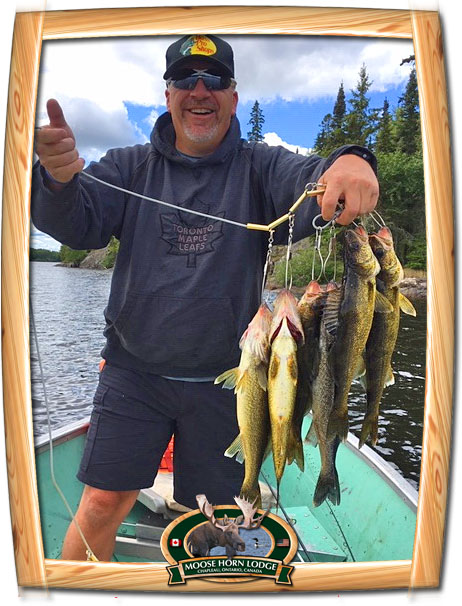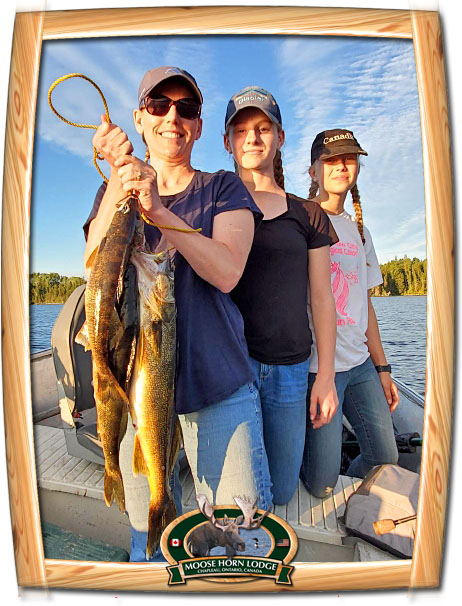


 Our lodge is located on McLennan Lake, which is about 10 miles south of Chapleau. Our lake is smaller than some of the big lakes in the area and is a crystal clear lake spring fed lake. We have implemented a catch and release program policy for walleye on the lake for the next couple of years and will revisit the policy after that. You can keep any northern pike and whitefish that you catch.
Our lodge is located on McLennan Lake, which is about 10 miles south of Chapleau. Our lake is smaller than some of the big lakes in the area and is a crystal clear lake spring fed lake. We have implemented a catch and release program policy for walleye on the lake for the next couple of years and will revisit the policy after that. You can keep any northern pike and whitefish that you catch.
McLennan Lake is not the main focus of our Walleye fishing. We have an 85% repeat business with our guests that are fanatical about Walleye because of all the fishing opportunities. We have a dozen other Walleye lakes within a 10 to 60 minute drive from the lodge. Ideally if you want to take advantage of the fantastic Walleye fishing in the area you should have a pick-up truck, jeep or SUV with a trailer hitch and 2-inch ball. 4x4 drive is an added bonus in the spring when some of the roads are muddy.
We have fishing boats on trailers ready to go. You just hook them up to your hitch and you are on your way.
Walleye fishing in the other lakes is awesome. The smaller lakes tend to produce high numbers of smaller Walleyes in the 1 to 3 pound range. We have had guests tell us they have caught dozens of Walleye in a day. The bigger lakes produce bigger Walleye but they are also more spread out and harder to find. On the big lakes you can catch a Walleye in the 7 to 10 pound range. When you catch a trophy Walleye please take a picture and let it go. A 10-pound Walleye is a female and can produce 500,000 eggs per year. We would like you to release any walleye 18" and over. It takes many years for walleye to grow and reproduce and the ones that are 18" and over are at that stage and keeping them will eventually hurt the population.
Prime Walleye fishing is either very early in the morning or evening especially on sunny days. On cloudy days, you have a little more leeway. We instruct our guests to fish other species like northern pike, trout and smallmouth bass during the day and fish walleye after supper until dark.
Walleyes can be funny critters. Their feeding patterns change based on time of year, water temperature, atmospheric pressure, light penetration, wind and waves and location of primary food sources.
In some big deep lakes where Smallmouth Bass have eaten the shore clean the Walleyes take off into deep water and are much harder to catch. We are not going to discuss deep-water techniques to any extent in this article because all the backcountry Walleye lakes around Moose Horn Lodge are shallow and easy to fish. The Walleyes in our area are rarely deeper than 15 feet other than late fall.
Spring:
In the spring 90% of a lake's Walleye population will be either right along the shore near sandy areas, in small streams and rivers or around sand bars that have at least a tiny bit of cover such as wild rice or lily pads. The reason they are there is because they spawn on sand just after ice out. The smaller males in the 1 to 2.5 pound range will stay shallow all day in early spring unless it's an unusually hot and sunny day for that time of year. When they do go deeper to avoid sunlight they will not go any deeper than 5 feet. However, the big spawning females will go off into deep water during the day especially if they have not dropped all their eggs. Full of eggs and exhausted by being hounded by males makes them very vulnerable to attack by Northern Pike so they seek protection in the deeper water.
You want to cast small shallow-running Rapalas, Rebels, Thundersticks or any small bait but you need to be able to stay shallow. 3/8th oz. jigs are best for Walleyes in our lakes. Bright colors like red, yellow, chartreuse or fire-tiger work best for the small males in the spring. If it's windy and you are drifting over the Walleye hotspot then drag a spinner or a worm harness with a nice fat worm.
The best way to find the Walleye hotspots is to troll along the shore until you get into them and then shut the motor off and start casting or keep drifting over the area. If you keep trolling back and forth you will spook the Walleyes and may even damage their spawning beds. In the spring Walleyes are one of the easiest fishing to catch, which is one of the reasons they are so popular.
 Late Spring into Summer:
Late Spring into Summer:Walleye feed very aggressively in the morning. From day break until 9:30am on super clear lakes or until 10:30 on lakes with normal clarity. They usually start feeding again late afternoon after dinner. This is based on a normal sunny summer day. If a weather system comes in and it started raining or becomes cloudy and overcast, the Walleyes may feed well all afternoon. Even on sunny days the Walleyes will start feeding if the wind picks up and the wave action deflects enough light to lower light penetration into the water.
During the day the best and most popular method of catching Walleyes is with light jigs. 1/8 to 3/8 oz is the best size. Small white unscented twistertails or salted twistertails work best. Scented baits do not work well in the north. They are designed for southern waters where there are a lot more suspended particles in the water. However salted baits work great in the north.
Even though white twistertails work best; on some days black, yellow or green can be the hot colors. It is best to use a small twistertail so you have lots of hook showing. This way you can tip the hook with a piece of worm or a small minnow. Walleyes like worms and minnows.
Hot Summer Afternoon:
Most guests fish for Walleye early morning or in the evening and then concentrate on Northern Pike and Smallmouth Bass in the afternoon. As the afternoon sunlight penetrates the water many people think the Walleyes have stopped feeding. In actual fact, the Walleye are blinded by the sun. This is when the Walleyes go down to the bottom and also look down to protect their eyes. In this case try putting a worm on a hook or a minnow on a hook and just let your line sink to the bottom and sit on bottom. You will be surprised that the Walleyes are still feeding. They are just not going after anything suspended in the water because they can't see well in bright light. Their sense of smell will guide them to the bait just like a catfish.
Summer Night Fishing:
Just before dark the big trophy Walleyes start to move in from the deeper water. For the first few hours after dark they will be right up into two feet deep of water. Trolling with light worm harnesses or shallow running lures works best. Different colors will work, especially in the spring. Later on in the summer the Walleyes tend to go after more natural colors such as black & Silver or brown & silver. When fishing at night the very best color is blue & silver. Walleyes have super night vision and at night they are sensitive to a different light spectrum, which could explain why blue works so well.
Deep Water Walleyes:
Generally all our lakes are shallow and fishing deep is not necessary. There is a chance that you find a deep hole just off a rocky point where you are catching lots of Walleyes. There is a chance that this hole might be hiding a couple big trophies. In this case you may want to troll slow and deep with light action techniques such as a 3-way swivel Walleye rig or a Loten Walleye Rig. It's easy to find information of these rigs with Google.